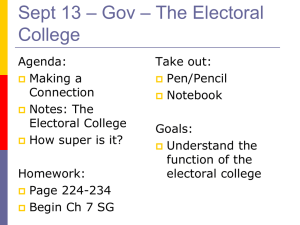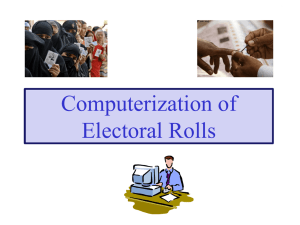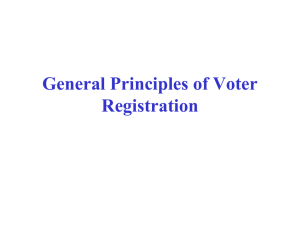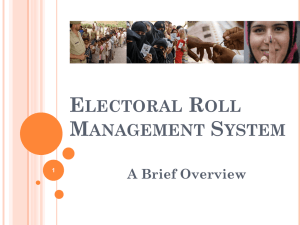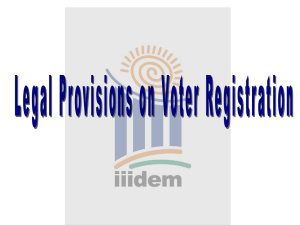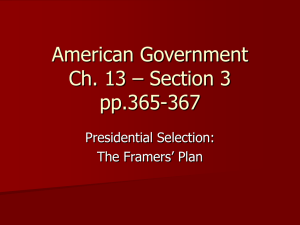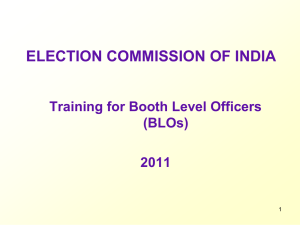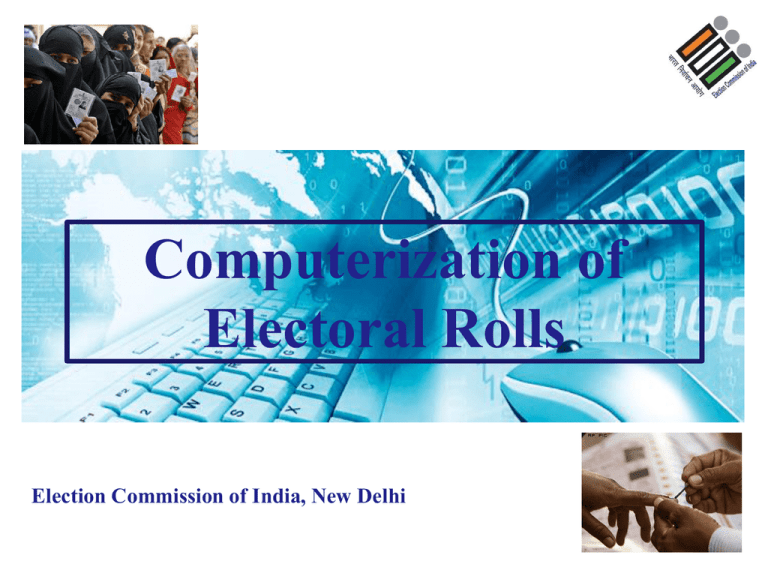
Computerization of
Electoral Rolls
Election Commission of India, New Delhi
WHAT IS AN ELECTORAL ROLL
• Electoral Registers or Electoral Rolls are prepared
under the provisions of Representation of People Act,
1950 and Registration of Electors Rules, 1960.
• Electoral Roll or voter list is –
– A basic document of electoral process
– When a notification for electing a member of
legislature or parliament is issued it means calling
upon the persons who are enrolled as electors is
electoral roll.
• An accurate and defect free roll is first requisite for a
free and fair election.
– Accurate roll ensures that while all eligible electors
are included in roll, all ineligible persons have been
excluded there from.
2
PREPARATION OF ELECTORAL ROLLS
1. The Rolls are prepared Assembly Constituency-wise.
2. Only one general electoral roll –
•
No separate roll is prepared on the basis of caste, creed,
religion, sex etc.
3. The rolls are revised annually.
4. The rolls revised with reference to a particular
qualifying date.
5. The Electoral Registration Officer (ERO) is
responsible authority for revision of rolls in the
Constituency.
3
BASIC FORMS OF APPLICATION
1.
2.
3.
4.
5.
Form 6 (for addition)
Form 6A (for addition of overseas electors)
Form 7 (for objection / deletion of an entry)
Form 8 (for correction of an entry)
Form 8A (for transposition of an entry within
the Constituency)
4
MAIN STAGES OF REVISION OF ROLLS
1. Preparation of draft.
2. Publication of draft
•
Filing of claims and objections.
3. Disposal of claims and objections
4. Final publication of rolls.
5. Continuous updation (between two revisions)
5
Electoral Roll in English
6
THE HIERARCHY OF ELECTORAL
MACHINERY
ELECTION COMMISSION OF INDIA (ECI)
CHIEF ELECTORAL OFFICER (CEO)
DISTRICT ELECTION OFFICER (DEO)
ELECTORAL REGISTRATION OFFICER (ERO) /
ASSTT. ELECTORAL REGISTRATION OFFICER (AERO)
BOOTH LEVEL OFFICER (BLO)
7
•
Electoral Units in
India
Parliamentary Constituency
Assembly Constituency
Parts (Polling Stations)
Sections
• Administrative Units
in India
State
Districts
Tehsils / Sub Division
Blocks
Villages/ Towns/ Metros
(Panchayats)
(Municipalities)
8
Database Structure
•
•
•
•
•
Earlier the Electoral Rolls in the Country were prepared manually.
In 2002, the Electoral Rolls in India were computerized.
Electoral Rolls are computerized i.e. maintained in a relational database
organized into tables prescribed by ECI
Database is stored in two set of tables:
1.
Control Table - Defines relationship between Electoral units such as
Parliamentary constituencies, Assembly Constituencies, Parts,
Sections and administrative units
1.
Elector Details’ Table – Provides details of the electors
Database is updated during every revision process
9
DATABASE STRUCTURE
•
•
•
During the draft publication, the Control Tables and
e-details database is used to prepare the draft roll in
pdf format.
After draft publication, the claims and objections are
disposed. The accepted claims and objections are
entered in the database.
Final publication is made after incorporating the
changes on account of deletions (by showing a mark stating
“DELETED” diagonally across the entry in the mother roll) and
modifications (appending # mark against the entry in the mother
roll) and a supplementary roll showing list of
additions, deletions and modifications separately.
10
Supplementary Roll
11
Control Tables
•
Details in Control tables are required:
– For printing details on the Part header
– For data integration of database of all electors in the State
– Prepare the Draft Rolls in PDF format
•
Accepted claims and objections are entered in the system and then Final Roll is prepared
by incorporating all deletions and modifications
•
It is very important to prepare control tables with extreme care and diligence so that the
Electoral Rolls are properly generated
•
The Control tables are entered once and used multiple times for roll preparation. An
error in control table can magnify multiple times, so utmost care has to be taken while
preparing control tables.
•
If the control tables are not filled timely and correctly then all the pains taken by
EROs to ensure the enrollment of eligible persons would be wasted
•
DEOs are responsible for collection of this data from the field.
•
EROs supervises the data entry by data entry operators (Vendors)
•
State Level Agency (SLA) provides the technical support
12
Part Header Page
13
Control Tables
•
To ensure the correct updation of database it is vital to have close
coordination between SLAs (technical guide), DEOs (collects data) and
the Vendors (enter data)
•
ECI identifies and lays down the structure of the control tables.
•
Some major tables are shown in the next few slides
14
Control Tables
•
Five tables which defines the relationship between districts, Assembly
Constituencies and Parliamentary Constituencies.
STUTLIST
List of States/UTs
NO.SEATS
5 Tables
PC_LIST
No of Parliamentary &
Legislative Assembly
Seats
List of PCs
AC_LIST
List of ACs
DISTLIST
List of Revenue Districts
15
Control Tables
•
Three tables which define the relationship between Districts, Assembly
Constituencies and Parliamentary Constituencies which are:
PC DIST
AC.DIST
3 Tables
Districts included in PC
Districts included in AC
AC PC
PC with Parts lying in AC
16
Control Tables
•
Four tables to provide details of Polling Stations, Parts and Sections.
AC. PARTS
Parts in ACs
PS.LOCN
Polling Station Locations
4 Tables
PS.AUXY
List & Details of Auxiliary
Polling Stations
SEC. DETAIL
Sections within the area
17
corresponding to Part
Control Tables
•
Ten tables which lists administrative units and their relationship with each other
List of subdivisions
SUBDIVS
TEHSELS
POST_OFF
List of Post
Offices
POLICEST
List of Police
Station
TOWNS
List of towns
administered by
Notified Area
Councils
METROS
List of towns
administered by
Municipal
Corporation
10Tables
PANCHAYT
List of
Panchayats
List of Tehsils
MTRODIST
BLOCKS
List of Districts in
Part
VILLAGES
List of Villages
List of Development
Blocks
18
Control Tables
•
Two tables which lists Talati/Patwari and Kanungo Circles
Reserved Forests
List of Reserved
Forests
2 Tables
Codes
List of various codes
used in Database
19
Elector Details’ Tables
•
Contains information about individual electors i.e. 8 column information
on electors shown in the Electoral Roll
•
List of electors is contained in 3 types of e-detail table:
1.
2.
3.
List of general voters i.e. data of every voter in column 8 format
Information of Service Voters
Information on amendments as a result of continuous updation or
revision
E_DETAIL
Details of General Electors
SE DETL
3 Tables
Details of Service Electors
SUP_DETL
Details of Amendments
20
Data Entry and Data Security
•
List of amendments are entered into a database using a software
provided by SLAs in CEO’s office during every revision
•
Data is entered with utmost care ensuring error free entries as it
will be published as Roll later
•
EROs ensures that manuscripts of additions, deletions and
corrections are entered timely and correctly
•
BLO goes through checklists and certifies that correct data is
entered in the database after the corrections made by ERO in the
Roll
•
Data entry work is undertaken in secured environment where safe
and exclusive space can be provided
•
Data and Equipments for data entry remains in the custody of
DEO/ERO. ERO must adhere to the elaborative guidelines for
data safety and security.
21
Data Safety and Security
•
•
•
•
•
•
•
•
•
Proper police verification of all temporary and casual data entry operators
proposed to be engaged by vendors.
Proper security arrangement at Designated Photography Location (DPL)
centers.
Identity card to staff of DPL centers to be displayed permanently by staff
member.
Designated officer for all aspects of DPL functioning. He should open and lock
the DPL and keep keys with him. He is accountable for DPL’s functioning.
Logbooks to be maintained for opening and closing of DPLs countersigned by
designated officer.
Separate logbook for movement of equipments. Every movement should be
accompanied by designated officer.
Database kept only at State level in the custody of CEO
Surprise visits to DPL
Daily verifications of EPICs prepared during the day.
22
Data Safety and Security
•
•
•
•
•
•
•
Proper account of holograms for EPIC. Responsibility of DLO.
The records of Holograms must tally with EPICs issued, balance with officer
for safe custody.
Proper record of damaged and wasted holograms.
Criminal action under law if accounts of holograms do not tally – against
vendor/officer responsible.
Agreement should mention clause that vendor has to return the database
after work is over. Otherwise there can be penal provisions.
Database should be properly sealed in cover while taking out of DEO’s
office. Record of person taking out should be maintained.
The DPL, room must be sealed after day’s work and keys should be with
designated officer.
23
Data Entry and Data Security
• All forms received on paper must be
computerized immediately and data uploaded on
CEOs server
• Data entry can be done in off-line mode with
batch upload
• Processing of data should start only after it is
uploaded on the Server
• Full data base security at server level is essential
• Data is uploaded on a database separate from
electoral data base. It may be called uploaded
data base
• Data is shifted from uploaded to electoral
database only after full enquiry and approval by
ERO with digital signature authentication by
ERO
24
REPORTS
• After every revision, to verify the integrity of the data and to
ensure that it reflects the correct administrative and electoral
position, 10 reports are prepared and verified against the actual
position :1.
2.
3.
4.
5.
6.
7a.
7b.
7c.
7d.
8.
Summary Information on Administrative Units
List of ACs and their corresponding Districts
List of ACs and their corresponding Districts & Tehsils
AC wise No. of Parts and Polling Station Locations
AC and Part wise list of Polling Station
AC wise number of Villages/ Towns/Forests/Metros
AC and part wise list of Villages/ Towns/Forests/Metros
Block and Panchayat wise villages
District, Tehsil and Police Station wise Villages
District and Tehsil wise Towns
AC and part wise number of Sections
25
Reports
• Report on Statistical Analysis in format 1 to 8
analysing EP ratio, Sex Ratio, Age Cohorts etc
• Report on number of claims and objections
received in form 6, 6A, 7, 8 and 8A and
percentage of claims and objections accepted
• Report on deletions giving deletions based on
Form 7 and suo-moto deletions separately
• Report on number of inclusions, deletions and
net increase in number of Electors
26
Electoral Roll Management System
(ERMS)
• It’s a window based application developed for using web
services as a database retrieval technique.
• It covers the entire process of Electoral Roll preparation in
the states from electoral roll revision, data management
process, electors’ registration, correction and data
modification to final publication of Electoral Roll and
preparation of Electors Photo Identity Card (EPIC).
• It also has some additional tools for providing citizen
services i.e. search facility, voter slip and tracking current
status of your application.
27
Key Features :• A secure and robust RDBMS SQL Server 2008 is used as
a back end.
• All the modules of ERMS are audited by NICSI
empanelled agency.
• Using centralized database for secured and better
management for various purposes.
• Date and time stamping is used for each record while
updating database.
• Auto toggle option is available to switch between various
vernacular and English language.
28
Key Features :• Each and every application (Form 6/7/8/8A and 6A)
received is digitized.
• Separate database is used to keep the data of Form 6, 7,
8, 8A and 6A.
• Only ERO/AEROs have write permission on the main
electoral roll database and i.e. secured by ‘Digital
Signatures’.
• Provision to print check lists for EROs/AEROs and
BLOs at various levels.
• Facility to crop uploaded images if needed for better
alignment.
29
Key Features :• EPIC printing is done as specified by the Commission that
includes EPIC dimensions as well.
• Various MIS reports are incorporated as specified by the
Commission.
• Photographs used in the software as a binary data.
• Date format used in the various modules is dd/mm/yy
complaint.
• A facility to sort voter list using House No that may be
customized State wise.
• EPIC is printed using data of main electoral roll.
30
Key Features :• Facility to track each and every application using unique key
number.
• Online search facility is available to search on the basis of
name and EPIC No i.e. provided District and AC wise in
English and vernacular.
• EPIC based search facility to generate voter slip on mobile.
• A tool to rationalization of polling stations is provided.
• Managing auxiliary polling station is incorporated.
• Facility to fill up online Form 6, 7, 8 and 8A using Public
Grievance Redressal (PGR) website (Citizen Services).
31
Architecture of ERMS
State Level
System
Control Table
Electoral Roll
ERO
Uploaded
Bulk Export
BLOs
Door to door
verification
Managing Electoral
Roll that includes
insertion, deletion,
updating and
transposition within
AC. And printing of
Electoral Roll
including one or
multiple
supplementary list.
Local Machine
Form 6
Form 7,8 & 8A
Electors
= Database 32
Component Description (Modules)
• Admin Module ( For managing users )
• Intensive / Summary Revision Data Upload
Application
• ERO / AERO Application
• Integration and Roll Printing Application
• Electors’ Photo Identity Card Preparation and
Printing Application
• Searching Module (Web/Mobile based)
• Control Table Management Module
33
Summary Revision Data Upload
• An application used to Add, Delete and Update the
Electoral Roll. This application is supported by 4
prescribed formats : • Form 6 - For inclusion of name in Electoral Roll
• Form 7 - For objection to inclusion of name in
Electoral Roll
• Form 8 - Application for objection to particulars
entered in Electoral Roll
• Form 8A - Application for transposition of entry in
Electoral Roll. (Within AC)
• Form 6A – NRI Applications
34
ERO / AERO Application
• This application is for the Elector Registration Officer to
approve revisions made through ‘Summary Revision
Data Upload Application’.
Roles of ERO
• Assign Enquiry Officer for each parts of the AC for each
type of forms received i.e., Form6, Form7, Form8,
Form8A.
• After BLO verification, this application is used for
either approving / rejecting cases.
• Updating records in the main database of electoral roll.
35
Integration and Roll Printing
• This software is used for integration of electoral roll that
means for merging Mother Roll and one or more
supplementaries*.
• For the printing Electoral Roll ( Part wise ) with or
without photos.
• Printing of Part Header Page with Control Table Units
* Note : Supplementary List means new additions,
modifications and updations in the roll.
36
EPIC Preparation and Printing
• ERO can create EPIC for Electors using this
application. The main functionalities of this
application are : • To cross check and verify the data available at the
server for EPIC generation
• After verification of data the EPIC can be generated for
each elector in a pdf format.
• Provision to make duplicate EPIC.
• To generate MIS report on distribution.
37
Reports
• Report on Statistical Analysis in Format 1 to 8 analyzing EP
Ratio, Sex Ratio, Age Cohorts etc
• Report on number of claims and objections received in Form
6, 6A, 7, 8 and 8A and percentage of claims and objections
accepted
• Report on deletions giving deletions based on Form 7 and suomoto deletions separately
• Report on number of inclusions, deletions and net increase in
number of Electors
38
Thanks
39

